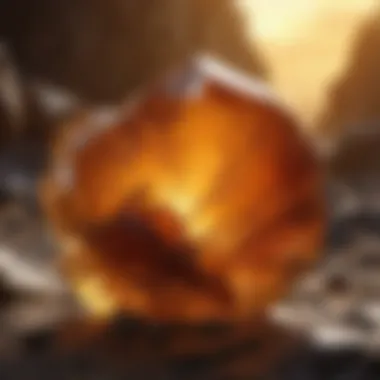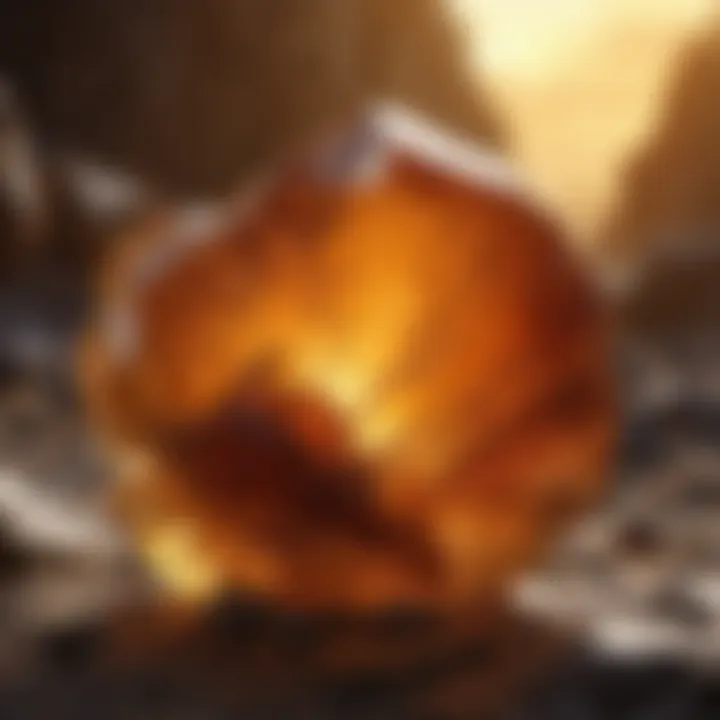The Allure of Amber: Nature and Cultural Impact


Intro
Amber is more than just a pretty stone; it’s a window into the past, a testament to the intricate processes of nature. While many know it for its decorative use in jewelry, the allure of amber extends much deeper. This article will explore amber's formation, its characteristics, as well as its significance throughout history and culture. The narrative will unfold its mesmerizing beauty and delve into its metaphysical attributes that resonate with collectors and enthusiasts alike.
Gemstone Overview
Definition and Characteristics
Amber is often considered a gemstone, though technically it is fossilized tree resin rather than a mineral. It possesses a warm range of colors, from a soft golden hue to deep reddish-brown. This variety arises from different types of trees and geological conditions, leading to distinct characteristics. What sets amber apart are its inclusions—trapped insects, plants, and even air bubbles, which tell stories from millions of years ago.
Classification of Gemstones
In the realm of gemstones, they can be divided into two broad categories: precious and semi-precious. Amber generally falls under the latter category, competing with others in the semi-precious realm like garnet and agate. Despite this classification, the demand for amber is significant, not only for its beauty but also for its unique qualities.
- Precious Gemstones: Diamonds, rubies, sapphires, and emeralds are generally considered precious due to their rarity and aesthetic appeal.
- Semi-Precious Gemstones: This category includes materials like amethyst, citrine, and of course, amber, which may be more abundant but still holds great value in the eyes of collectors.
Properties of Gemstones
Physical Properties
Amber has some fascinating physical properties that make it particularly interesting. One might note its lightness; it's lighter than most stones, which adds to its appeal in jewelry creation. Amber is also less hard compared to many minerals, ranking between 2 and 2.5 on the Mohs scale of mineral hardness. This means it scratches and wears more easily, so care should be taken when wearing amber jewelry.
"Amber is as much a touch of history as it is a piece of art. Every stone holds a slice of time, making it a captivating conversation starter."
Chemical Properties
When considering chemical properties, amber is primarily composed of carbon, hydrogen, and oxygen. Its composition can vary based on environmental factors during its formation. This lack of a definitive chemical structure is notable, as most gemstones have a fixed formula. The organic nature of amber means it can undergo changes over time due to heat and exposure, which can affect its color and clarity.
Thus, the exploration of amber is not just a study of a gemstone; it's an intricate tapestry of nature’s artistry woven over millions of years. This overview sets the stage for deeper discussions on its unique formation, historical background, and cultural relevance—each thread enriching the understanding of amber.
End
Amber continues to capture the imaginations of gemstone enthusiasts and collectors. Its blend of beauty and history affords it a unique position in the world of gems. As we delve further, we’ll explore the formation process of amber, its significant role in various cultures, and the metaphysical beliefs surrounding it. \n This exquisite stone, steeped in history, awaits its stories to be told.
Prologue to Amber
Amber has a charm that draws people in, and its unique qualities make it a subject worth exploring in depth. This introduction sets the stage for a thorough understanding of amber, illuminating its importance across various realms—from geological to artistic and cultural.
Why does it matter? First, it touches on history. Amber has been a part of human civilization for thousands of years, serving not just as a beautiful material for adornment, but also as a medium of trade and cultural expression. Second, understanding amber’s formation gives valuable insight into Earth's processes, showcasing nature's ability to preserve life in resin for millions of years. Engaging with amber's story enhances our appreciation for its beauty, acting as a lens through which we can better understand both the past and the present.
What is Amber?
Amber is fossilized tree resin, a product of ancient coniferous trees that released their sap for various reasons, perhaps even as a defensive mechanism against pests. Over millions of years, this resin buried under the Earth's surface underwent a transformation—a slow metamorphosis that gradually turned it into a solid form.
Amber comes in various colors, ranging from deep browns and yellows to rarer hues like green and blue. It's not merely the color that captivates. The presence of air bubbles and inclusions, such as tiny insects or plant matter, adds a unique charm, as these trapped particles tell tales of ancient life. While some view it as just a gemstone, for others, amber embodies the very essence of time and history.
A Brief History of Amber
The story of amber is as ancient as the trees that produced it. Cultures have revered it for millennia. The earliest records date back to the Neolithic period, where amber artifacts have been discovered in archaeological sites across Europe. The Greeks referred to amber as "electron," believing it possessed special powers and is even where the word "electricity" originates.
In the Baltic region, amber has held significance in trade, often termed "gold of the North." Ancient traders would exchange amber for goods, and its allure has not waned with the passage of time. It found its place in jewelry, religious artifacts, and even medicine in various cultures. These historical narratives reveal how amber not only brightened the lives of those who adorned themselves with it but also shaped economies and traditions.
"Amber is a window into the distant past, preserving a moment in time—one that connects us to both nature and history."
Engagement with amber invites exploration into human history and the natural world. As we navigate the complexities of its origins and significance, we begin to appreciate amber not just as a beautiful stone, but as an enduring legacy that resonates with our collective past.
Geological Formation of Amber
Understanding the geological formation of amber is pivotal to appreciating its beauty and historic significance. Essentially, amber serves as a time capsule containing the remnants of ancient life, trapped within the resin. The process of amber formation reveals much about the conditions of the Earth during ancient epochs and emphasizes amber's unique position in both geology and anthropology. This section covers how resin transforms into this coveted gemstone and the expansive timeframes associated with its creation.


The Resin to Stone Process
Amber originates from the sticky, viscous sap of coniferous trees. When trees exude this resin, it might capture insects, plant matter, or even bubbles of air in its embrace as it drips down. Over time, the collected resin undergoes a transformation due to several factors, which include heat, pressure, and the influence of microbial activity.
The important steps in the resin to stone process include:
- Excretion: Trees release resin as a defense mechanism to heal wounds or deter pests.
- Burial: If the resin seeps into the ground and is covered by sediments, it begins to form an amber deposit.
- Polymerization: Through a process involving evaporation of volatile compounds and polymerization, the resin hardens over millions of years.
- Mineralization: Eventually, this process leads to the creation of amber, a fossilized resin that retains its original characteristics, including unique inclusions of flora and fauna.
This fascinating metamorphosis from sticky sap to a gleaming piece of amber can take thousands to millions of years.
Geological Timeframes Involved
The formation of amber is a sluggish affair, operating on a time scale that can be quite hard to fathom for many. Amber deposits mainly date back to the Cretaceous and Miocene periods, which span millions of years. Such vast geological timeframes allow us to uncover significant details about the Earth's past.
Depending on the region and specific environmental factors, amber can form over a varied timespan. For example:
- Cretaceous amber: Typically around 100 million years old, often originating from ancient forests.
- Baltic amber: Usually dating back to the Eocene epoch, around 44 million years ago, carries a notable amount of insect inclusions.
Understanding these timeframes contributes to the appreciation and value of amber. The rarity of older amber specimens creates a desirability for collectors, contributing to a thriving trade based on their geologic and historical significance.
"Amber is the last echo of a living world, a window into a distant past."
As we continue to explore amber's characteristics and cultural significance, knowing its geological formation deepens the connection between this remarkable material and the ancient One, emphasizing how it is much more than mere decoration.
Characteristics of Amber
Amber is more than just a pretty stone; it carries a hefty weight of history, culture, and scientific intrigue. Understanding its characteristics enables not only admirers but also collectors and jewelers to appreciate its nuances. These aspects help in identifying genuine amber from imitations and provide insights into its value in both the markets and in art. Furthermore, the visual and tactile properties of amber create an emotional connection that enhances its allure.
Color Variations and Their Significance
The spectrum of amber hues impressively ranges from golden yellows to deep, rich browns and even hues of green or blue. These color variations aren't just for aesthetic charms; they often indicate the conditions under which the resin formed. For instance, the classic shade of honey amber might suggest a specific age or type of tree resin that has undergone a unique fossilization process.
In many cultures, colors also carry symbolic meanings. Light amber could signify purity and vitality, while darker shades may be associated with mystery or strength. Collectors often find that the rarity of colors like blue or green is yet another factor that drives value. Knowing these color cues helps enthusiasts better gauge the quality and significance of their amber pieces.
"Color is a language; it can speak volumes where words often fail."
When choosing amber for jewelry or artistic applications, a discerning eye can spot color shifts even within pieces. Pieces with a deeper translucence tend to glow warmly when light hits them, making them particularly sought after.
Physical Properties and Identification
Amber is lightweight yet robust, making it ideal for various applications. It doesn’t feel cold to the touch like many gemstones, offering a unique tactile experience. This characteristic is particularly notable when compared to heavier stones like onyx or jasper. The density of amber can aid novice collectors in identifying genuine pieces, as authentic amber typically floats in saltwater.
One of the most distinguishing traits of amber is its ability to hold imprints of organic materials—fossilized insects or plant fibers often found within. These inclusions tell a story of the past, making amber not just a jewelry item but a window into another time. The presence of these fossils can further enhance a piece's value, particularly if the inclusion is rare.
Here are some quick tips for identifying real amber:
- Smell Test: Real amber gives off a pine-like scent when rubbed.
- Heat Test: If you heat it slightly, authentic amber might emit a pleasant resinous aroma, while fake materials might smell of plastic.
- Visual Inspection: Look for tiny air bubbles or organic inclusions—indicators of genuine amber.
By understanding these physical properties, aficionados can better appreciate the craftsmanship behind the items they cherish. Knowing what to look for enhances the whole experience, allowing them to connect with amber on a deeper level.
Cultural Significance of Amber
Amber has long captured the imagination of various cultures around the globe. Beyond its aesthetic shine and warmth, amber holds deep cultural significance. Its use transcends mere adornment, serving also as a bridge connecting ancient traditions with modern practices. The stone's history weaves into the fabric of civilization, symbolizing wealth, protection, and even spirituality.
Amber in Ancient Civilizations
Throughout history, amber has appeared prominently in the stories and artifacts of ancient civilizations. For example, the Egyptians revered amber, often crafting it into amulets for protection in the afterlife. They believed that amber could ward off evil spirits, making it a sought-after material for burial practices.
Similarly, in Baltic regions, the Vikings valued amber for trade and craftsmanship. They would carve intricate designs into amber, creating both functional objects and decorations. The ancient Romans, too, recognized the beauty of amber. They used it for jewelry and as a decorative element in their homes. Curious enough, it was said that they believed amber had medicinal properties, using it to treat various ailments.
One notable excavation in the vicinity of the Amber Road revealed artifacts dating back to 6,000 BCE, indicating that trade routes existed as far back as prehistory. The trade of amber facilitated not just economic exchanges but cultural interactions, fostering connections between diverse regions and peoples.


Myths and Folklore Surrounding Amber
Amber has found its way into a myriad of myths and local folklore, painting it as a mystical stone. In many cultures, people believed that amber held the souls of ancient trees or even contained the tears of the sun. For instance, the Greeks regarded amber as a gift from the sun, reflecting its warm hues reminiscent of sunlight.
In Slavic tradition, amber was often associated with the concept of immortality. Folklore would suggest that wearing amber could bestow longevity and strength to the wearer. Some believed that it acted as a safeguard against sickness, amplifying the body's natural energies.
"Amber is not just a stone; it's a vessel of our past, holding within it stories old as time."
Distinctive tales have been told in various cultures about the origins of amber, seeking to explain its alluring nature. For example, in some Native American tribes, it was believed that amber embodies the life force and vitality of nature. This connection between amber and life resonates with people even today, fueling its enduring allure.
In contemporary society, the fascination with amber continues. Many still hold on to the myths, wearing amber jewelry with the hope that it can provide protection and enhance well-being. This blend of history, beauty, and belief ensures amber remains a symbol of rich cultural heritage, captivating not only gemstone enthusiasts but also those interested in the stories each piece carries.
Uses of Amber in Art and Jewelry
Amber, with its warm hues and captivating appearance, has long mesmerized artisans and designers alike. Its versatility extends beyond mere aesthetics; it weaves through history, culture, and even spirituality. As we delve into the uses of amber in art and jewelry, we uncover how it has transformed from a natural resin into a cherished medium of expression and craftsmanship.
Amber in Traditional Crafts
Amber has been utilized in traditional crafts for centuries, particularly in regions where it was abundant. Its beauty made it a favored material in creating amulets, beads, and intricate carvings. Artisans from ancient times recognized the exquisite nature of amber and the aura it exuded, often attributing spiritual qualities to it. For instance, Baltic cultures have a rich tradition of crafting amber into ornamental pieces, used not only for adornment but also as protective charms.
The crafting process, while often labor-intensive, allows for a great degree of creativity. Silversmiths and woodworkers have historically combined amber with other materials, creating hybrid pieces that tell stories of different cultures. The skill required to shape and polish amber speaks to an artistic tradition that values both aesthetic beauty and functional craftsmanship.
Furthermore, amber’s history within folk art provides intriguing tales. Many traditional pieces feature motifs and designs that signify protection, fertility, and connection to nature. This cultural significance adds layers of meaning to amber artifacts, making them not merely decorative, but also symbolic representations of a community’s heritage.
Modern Applications in Jewelry Design
In contemporary times, amber has found a renewed place in jewelry design. It blends effortlessly with modern styles while maintaining a touch of timeless elegance. Designers today often exploit its natural imperfections, recognizing that each piece carries a unique story – a testament to the many years it has spent in formation.
Modern jewelry pieces range from classic pendants to avant-garde designs that challenge the norms. The translucence of raw amber sets it apart; its often organic shapes allow for innovative creativity, making it a staple in both designer collections and artisan markets.
Moreover, with the growing trend of sustainable fashion, many jewelers are using ethically sourced amber crafted under environmentally friendly practices. This shift caters to an audience increasingly concerned with the origins of their accessories, marrying style with conscious consumerism.
Here are some popular modern uses of amber in jewelry:
- Statement rings featuring large, polished amber stones that catch light beautifully.
- Necklaces with layered strands of amber beads providing a playful yet sophisticated look.
- Earrings that highlight the natural inclusions within amber, telling a story of the ancient life trapped within.
"Amber is often described as nature's time capsule, preserving a moment in geological history."
Amber's appeal and versatility offer endless possibilities in jewelry design. For gemstone enthusiasts, collectors, and designers, its unique properties and vibrant palette ensure that amber remains a favored choice in the ever-evolving world of art and jewelry. Its deep-rooted history, paired with modern innovations, solidifies amber's status as both an artistic medium and cultural icon.
Metaphysical Properties of Amber
Amber is not just a beautiful fossilized resin; it is steeped in a rich tapestry of metaphysical properties that have fascinated many over centuries. This section will dive into the depths of what makes amber significant in spiritual and healing practices. For gemstone enthusiasts and collectors alike, understanding these metaphysical attributes is an integral part of appreciating amber not just as a decorative item, but as a vessel of cultural and spiritual significance.
Spiritual Significance
Amber is often regarded as a powerful tool in spiritual practices. Many believe it helps one connect with the Earth’s energies, grounding the user in their daily lives. This connection to the Earth’s core allows individuals to find their footing when life feels tumultuous. The warm hues of amber are thought to radiate positivity and clarity, making it a favored choice during meditation and reflection. Those who seek emotional balance frequently turn to amber, as its qualities are said to provide comfort and reassurance during challenging times.
"Amber illuminates the path through the shadows of uncertainty, serving as a guide for introspection and self-discovery."
Importantly, amber is attributed with the ability to dispel negative energies and transform them into positive vibes. It acts like a sponge, absorbing the emotional debris around the wearer. Many practitioners recommend wearing amber during spiritual rituals to foster an environment conducive to healing and growth. Perhaps it’s this blend of comfort and cleansing that makes amber a popular choice in various metaphysical communities.
Healing Properties Attributed to Amber
In the realm of healing, amber is often seen as a natural remedy for both physical and emotional ailments. Advocates assert that it is not merely a stone but rather a healer in its own right. Among its most touted benefits is its capacity to alleviate stress and anxiety. Users often share anecdotes about finding relief when wearing amber or keeping it close by during tense situations. It’s said to encourage positivity while warding off feelings of despair.
Moreover, amber is recognized for its alleged anti-inflammatory properties. Many even believe that it can ease the pain of ailments like arthritis and muscle soreness. This belief likely stems from the presence of succinic acid, a component of amber that's thought to promote healing within the body. When placed upon the skin, amber is believed to encourage a warming sensation that helps soothe physical discomfort.
In summary, the metaphysical properties of amber encompass both spiritual and healing dimensions. Whether used for grounding and emotional support, or for physical healing, its allure remains profound. As both an art object and a spiritual tool, amber continues to captivate and inspire those who seek its unique benefits.
The Global Trade of Amber


The global trade of amber is not merely a transaction of goods; it reflects a rich tapestry woven from cultural heritage, environmental awareness, and the demand for unique gemstones. As amber becomes increasingly sought after for its striking beauty and presumed metaphysical properties, understanding this trade is crucial for collectors, jewelry designers, and enthusiasts alike. The amber trade encompasses various aspects, from extraction to market value, each influencing the dynamics of this fascinating industry.
Regions Known for Amber Production
Amber is produced in several regions around the world, each contributing its unique character to the stones harvested. Here are some key areas:
- The Baltic Region: Perhaps the most famous for high-quality amber, especially in Poland, Lithuania, and Latvia. The amber here is often referred to as Baltic amber. Its warm hues and richness in inclusions attract collectors and artisans alike.
- The Dominican Republic: This area is notable for producing amber with vibrant colors, including shades of blue and green. Its tropical climate contributes to the distinct characteristics of the amber found here, which often includes numerous preserved insects.
- Mexico: Particularly in Chiapas, this region yields amber that’s known for its deep and rich colors. Often referred to as Mexican amber, it is part of the local artisanal traditions.
- Myanmar: Also known as Burma, this region has been a source of amber for thousands of years, with some specimens being up to 99 million years old, offering collectors intriguing glimpses into prehistoric life.
"Amber reflects not just a gem's beauty but echoes stories of ancient forests and life preserved over millennia."
Each of these regions has a distinct role in the global supply of amber, affecting market trends and buyer experiences. Importantly, the qualities and characteristics attributed to amber from different locales contribute to its desirability, affecting prices and collectors' pursuits.
The Impact of Sustainable Practices
The conversation around sustainability has woven its way into the amber trade, highlighting the necessity of responsible extraction and production methods. As environmental concerns continue to grow, both producers and consumers must navigate these pressures thoughtfully.
Some of the key points to consider include:
- Ethical Sourcing: The rising demand for ethically sourced amber is reshaping the industry. Buyers are increasingly aware of the environmental impact of amber mining, prompting many sellers to adopt transparent practices.
- Regulations and Certifications: Various organizations are beginning to establish certifications that verify sustainable practices in amber extraction. This not only helps protect natural resources but also adds value to ethically sourced amber.
- Community Involvement: Many regions involved in amber production have begun including local communities in the trade process, providing them with the means to sustain their livelihoods while protecting their environments. This, in turn, encourages preservation efforts and responsible harvesting of resources.
Challenges Facing the Amber Industry
The allure of amber is frequently overshadowed by the hurdles confronting its industry. It's not merely about its beauty and allure but also involves navigating a range of challenges that threaten production and trade. Recognizing these challenges is crucial for stakeholders, including collectors, designers, and enthusiasts. This section sheds light on significant elements that put pressure on the amber market and highlights considerations necessary for the industry to thrive in the future.
Environmental Concerns
One of the most pressing issues is the environmental impact of amber extraction. Many regions where amber is found, such as the Baltic area, face ecological strain due to mining activities. Deforestation, habitat destruction, and soil erosion are all risks linked to amber mining operations. The extraction process often disrupts fragile ecosystems, leading to a decline in biodiversity. Over time, damage to these ecosystems can have a snowball effect, impacting not just wildlife but local communities that depend on these natural resources.
"Sustainable practices in amber mining are not merely an option; they are a necessity for preserving the nature's delicate balance."
To address these concerns, there are ongoing discussions about regulating amber mining and promoting eco-friendly practices. Some companies are beginning to adopt more sustainable methods, like selective logging and habitat restoration, aiming to minimize their environmental footprint. Certification programs may also emerge to help consumers identify ethically sourced amber, encouraging a more responsible market.
Market Value Fluctuations
The market value of amber is another thorn in the industry's side. Price fluctuations can be wild, heavily influenced by factors like global demand, economic conditions, and the specific qualities of amber itself. For example, the market has seen consistent interest from collectors and jewelry designers, driving prices up, yet this enthusiasm can swing, leaving producers in a tight spot.
Certain factors lead to instability in amber prices:
- Quality Variance: The uniqueness of each amber piece introduces variability in pricing. Rare colors, inclusions, and types significantly impact their value.
- Cultural Trends: Shifts in fashion and design can cause sudden spikes or drops in demand. For instance, amber jewelry might be in vogue one season and become just another option the next.
- Economic Changes: Global financial situations, such as recessions, also play a role in consumer spending behavior, affecting the market’s vitality.
In addition to these factors, increased counterfeit products pose a challenge, complicating the assessment of genuine pieces and further destabilizing market values. As the industry faces these fluctuations, transparent practices and consumer education will be essential to maintain the integrity and stability of amber's market value.
Overall, understanding these challenges is key for anyone involved in the amber industry. Only by addressing environmental issues and market volatility can stakeholders hope to secure amber's legacy for future generations.
Culmination: The Enduring Legacy of Amber
Amber is much more than just a pretty stone. It holds within its golden hues tales of ancient civilizations, lessons from geological epochs, and a bridge to modern cultural practices. The allure of amber lies in its unyielding ability to captivate the human spirit, serving not only as adornment but also as a vessel of meaning.
Reflections on Amber's Historical Journey
Amber's history dates back thousands of years. From its use by prehistoric humans as a form of currency, to appearing in royal adornments, it has seen cultures rise and fall. Many ancient societies believed that amber had protective properties. The Greeks, for instance, called it "elektron," turning it into a source of mythology and beauty.
The fossilized tree resin has been found in burial sites, indicating its significance during rituals. In the Baltic region, the so-called "Amber Road" facilitated trade. Beads and artifacts made from this substance tell stories of cultural exchanges and the importance that amber held in commerce and social status.
From these historical snippets, we see a fabric woven through time. Amber has been cherished, honored, and revered across geographies.
Future Prospects and Cultural Relevance
As we march forward, the appreciation for amber doesn't appear to wane. Modern artisans are skillfully melding ancient techniques with contemporary designs, ensuring that amber jewelry retains its relevance. The rise of sustainable practices in gemstone sourcing offers a pathway for ethical consumption and preservation.
Emerging markets are discovering amber anew. With its growing popularity, especially in markets like Asia and the Americas, there's a renewed interest in education around its historical significance and geological origins. Collectors and enthusiasts alike are keen to learn, leading to workshops and exhibitions dedicated to amber's multifaceted nature.
Social media platforms also play a key role in shaping its modern narrative. Communities on sites like Reddit and various Facebook groups provide spaces for sharing knowledge and showcasing amber collections. This interconnectedness fosters a greater appreciation that transcends borders.
In sum, amber remains a symbol of continuity. As generations pass, its stories and significance adapt and evolve. The enduring legacy of amber speaks to our collective humanity, reminding us that within each piece lies not just beauty, but a rich history waiting to be explored.



